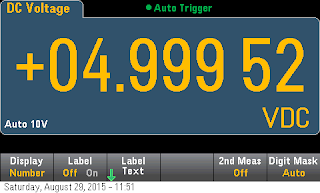- It took a *long* time for the output to settle. Sometimes as long as 40s or more. The voltage would get within a couple of mV of the target but the last digit would take a long time.
- The drift between different runs was huge. As much as 30mV
- The settling time was much longer when switching between the low and high range or vice versa.
I did some investigation and learned a few things including a truly face-palm worthy realization.
Op Amp Settling Time
I found an interesting application note from Analog Device (AN-395) that describes what effects the settling time of op amps, approximations for measuring the settling time and aspects of the amplifier's design that will determine the settling time. For example mismatch of the poles and zeros in the amplifier's open look transfer function will effect settling time. The table in that application note below was most useful:
The key things are that settling time is dependent on:
- Amplifier bandwidth
- The gain of the amplifier stage
- The level of precision required
The amplifiers I am using (LT1639) have a gain bandwidth product of 1MHz and the amplifier is taking the 0-5V from the DAC and multiplying it by 6 to generate the 30V output. If we use the table above for gain = 10 and accuracy = 0.01% (where we actually want 0.003% for 1mV out of 30V) it comes out to 1.5uS. This is far less than what I was seeing.
Resistor Effects
When I chose the resistors for the x6 amplifier, I chose a set of values to give me slightly more than x6 gain so I could get the full 0-30V range. I noticed the settling time issues and thought it could be that I chose values which were too low and was drawing enough current that heat was effecting the settling time. I tried choosing higher values but this didn't change much.
I found this chapter from a book called "Op Amp Applications" via Google books that proved to be useful. Essentially the author calculates the power dissipated by each resistor, notes that the feedback resistor carries much more current than the negative terminal resistor. He works out that based on the Tc for carbon resistors (which is shocking!) 1500ppm and based on the case-to-air thermal resistance that the error induced by voltage changes would be quite significant even with 14 bit resolution.
This is where I did a face-palm and realized that of course these crappy carbon resistors wouldn't match the 2ppm/K accuracy of my DAC. Not only that but the thermal effects probably cause some of the settling issues as the devices heat up and cool down.
It became apparent I need to find a more precision resistor. For now I am switching to carbon film resistors which have a tempco of more like 150ppm. I also started investigating resistors I could use in the final design including precision resistor divider networks such as this one which is a 25ppm 10K/2K resistor network. The good thing about this is that even though 25ppm is much higher than the 2ppm of my reference, both resistors are in the same package so the ratio. There are other packages worth considering but the cost tends to be pretty high.
Another option is to use surface mount resistors with low tempco such as these TE Connectivity 10ppm resistors and to place them physically close they will be at close to the same temperature. This won't help with self-heating however but when the tempco is so low the effect of self-heating is pretty small.
Loss of Resolution
Furthermore, in my zeal to cover the full range I missed the fact that by using a gain of 6.1 I was facing a significant loss in resolution. This I think partly accounts for why I would get quite different results between calibration runs.
I decided to use a 10k/2k ratio (so exactly 6). And did another calibration run. The results are pleasing! Here is the output when set for 1V, 5V 10V, 20V and 30V
I'm pretty sure that with the right resistors I should be able to nail this.






No comments:
Post a Comment